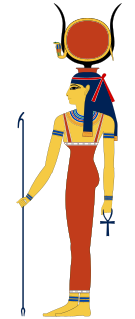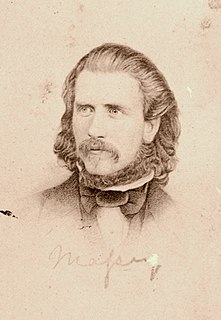Gardiner's Sign List is a list of common Egyptian hieroglyphs compiled by Sir Alan Gardiner. It is considered a standard reference in the study of Ancient Egyptian hieroglyphs.
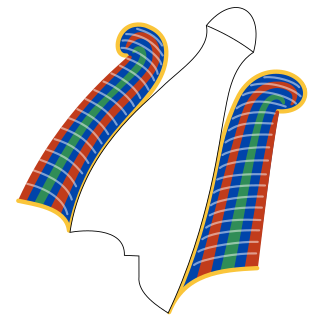
Atef is the specific feathered white crown of the ancient Egyptian deity Osiris. It combines the Hedjet, the crown of Upper Egypt, with curly red ostrich feathers on each side of the crown for the Osiris cult. The feathers are identified as ostrich from their curl or curve at the upper ends, with a slight flare toward the base. They are the same feather as (singly) worn by Maat. The crown is also worn by Sobek. They may be compared with the falcon tail feathers in two-feather crowns, such as those of Amun which are more narrow and straight without curve.
The ancient Egyptian harpoon,, is one of the oldest language hieroglyphs from Ancient Egypt. It is used on the famous Narmer Palette, of Pharaoh Narmer from the 31st century BC, in an archaic hieroglyphic form.
The ancient Egyptian Shuti, a two-feather adornment for crowns, is part of a series of hieroglyphs for "crowns"; usage as a hieroglyph is not as common as the actual crown represented in Egyptian art, and artworks.
The Egyptian hieroglyph for "black" in Gardiner's sign list is numbered I6. Its phonetic value is km. The Wörterbuch der ägyptischen Sprache-(Dictionary of the Egyptian Language) lists no less than 24 different terms of km indicating 'black' such as black stone, metal, wood, hair, eyes, and animals.

A quadrat block is a virtual rectangle or square in Egyptian hieroglyphic text.
The pectorals of ancient Egypt were a form of jewelry, often represented as a brooch. These were mostly worn by richer people and the pharaoh.
The ancient Egyptian Branch hieroglyph, also called a Stick, is a member of the trees and plants hieroglyphs.

The ancient Egyptian Sky hieroglyph,, is Gardiner sign listed no. N1, within the Gardiner signs for sky, earth, and water.

The Ancient Egyptian Townsite-city-region (hieroglyph) is Gardiner sign listed no. O49 for the intersection of a town's streets. In some Egyptian hieroglyphs books it is called a City Plan.

The ancient Egyptian Pick hieroglyph, Gardiner sign listed nos. U17, U18 is a portrayal of a 'pick upon the side view of a block'; it is in the Gardiner subset for agriculture, crafts, and professions.
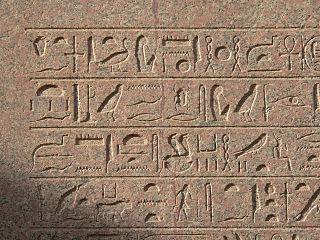
The ancient Egyptian Two Whips with Shen ring hieroglyph, Gardiner sign listed no. S23 is a portrayal of the Shen ring with two Egyptian flails-(Crook and flail); it is a member of the Gardiner subset for "crowns, dress, staves, etc".

The Egyptian hieroglyph ndj (nḏ) has the shape of a "cross". It presumably depicts some type of tool, such as a "mill". It is often written alongside the nu "pot" hierogplyph (W24). It is used as an ideogram or determinative in the context of "grains", "grinding stone", "grind", "to rub out".
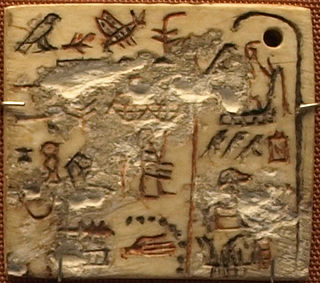
The ancient Egyptian Hand-with-droplets hieroglyph, Gardiner sign listed no. D46A is a portrayal of the hand, with droplet offerings. In the Old Kingdom usage it is found on ivory labels and slab stelas, presumably with the use of 'aroma' and unguents, or with incense. As the verb usage with 'libation', water or liquids are involved.
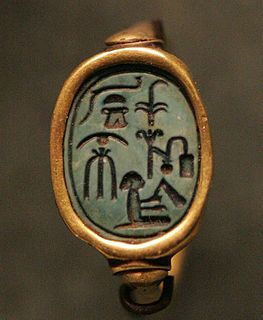
The ancient Egyptian Scribe equipment hieroglyph 𓏞, or its reversed form 𓏟, portrays the equipment of the scribe. Numerous scribes used the hieroglyph in stating their name, either on papyrus documents, but especially on statuary or tomb reliefs.

The ancient Egyptian Obelisk hieroglyph, Gardiner sign listed no. O25 is a portrayal of the obelisk. The hieroglyph is commonly used on erected Egyptian obelisks, as there is often a discussion of the event of its erection: a historical event, as well as an accomplishment of the pharaoh, and the Egyptian Kingdom.

The ancient Egyptian Bull (hieroglyph), Gardiner sign listed no. E1, is the representation of the common bull. The bull motif is dominant in protodynastic times, and also has prominence in the early dynastic Egypt, famously on the Narmer Palette. Its phonetic value is kꜣ.

